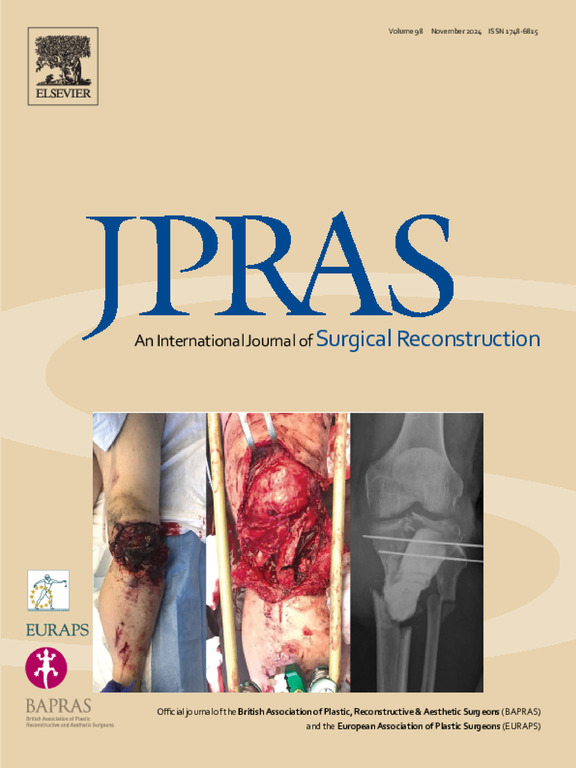A free-style approach to selection of locoregional perforator flaps for unilateral breast restoration
IF 2.4
3区 医学
Q2 SURGERY
Journal of Plastic Reconstructive and Aesthetic Surgery
Pub Date : 2025-07-08
DOI:10.1016/j.bjps.2025.06.040
引用次数: 0
Abstract
Background
Evolution in breast oncology has increased the use of breast-conserving therapy and expanded the role of locoregional autologous reconstruction. While bilateral reduction is common for patients with large, ptotic breasts, those with small to moderate symmetric breasts often prefer unilateral volume restoration. This study demonstrates a free-style approach to flap selection and design for partial and total breast reconstruction, emphasizing intraoperative decision-making and preservation of muscle and nerve function.
Methods
A retrospective review was performed on patients undergoing perforator flap reconstruction from 2016 to 2023. Demographic, oncologic, and operative data were analyzed. Flap type was chosen intraoperatively based on donor tissue availability, perforator quality, and defect characteristics and included thoracodorsal artery perforator flap (TDAP), muscle-sparing latissimus dorsi (ms-LD), lateral intercostal artery perforator (LICAP), and anterior intercostal artery perforator (AICAP) flaps.
Results
Twenty-three reconstructions were included: 18 following lumpectomy (78%) and 5 following mastectomy (22%). Reconstruction was immediate in 78% of cases. The average lumpectomy resection weight was 64 g, and the median operative time was 3.5 h. TDAP was the most frequently employed flap (52%), followed by ms-LD (21%), LICAP (13%), and AICAP (13%). Minor complications occurred in three patients, and only two patients experienced mastectomy skin flap necrosis requiring revision.
Conclusions
Locoregional perforator flaps provide reliable volume replacement with preservation of muscle function and minimal donor morbidity. The free-style intraoperative selection based on donor tissue quality offers versatile reconstruction without necessitating contralateral procedures.
选择局部穿支皮瓣进行单侧乳房修复的自由方法
背景:乳腺肿瘤的转移增加了保乳治疗的使用,扩大了局部自体重建的作用。而双侧缩小是常见的患者大,上睑下垂的乳房,那些小到中等对称的乳房往往倾向于单侧体积恢复。本研究展示了一种自由风格的皮瓣选择和设计方法,用于部分和全部乳房重建,强调术中决策和保留肌肉和神经功能。方法回顾性分析2016 ~ 2023年我院行穿支皮瓣重建术患者的临床资料。对人口统计学、肿瘤学和手术资料进行分析。术中根据供体组织的可用性、穿支质量和缺损特征选择皮瓣类型,包括胸背侧动脉穿支皮瓣(TDAP)、保肌背阔肌皮瓣(ms-LD)、外侧肋间动脉穿支皮瓣(LICAP)和前肋间动脉穿支皮瓣(AICAP)。结果共23例重建:乳房肿瘤切除术18例(78%),乳房切除术5例(22%)。78%的病例可立即进行重建。平均肿瘤切除重量为64 g,中位手术时间为3.5 h。TDAP是最常用的皮瓣(52%),其次是ms-LD(21%)、LICAP(13%)和AICAP(13%)。3例患者发生了轻微并发症,只有2例患者经历了乳房切除术皮瓣坏死需要翻修。结论同区域穿支皮瓣提供了可靠的容量置换,保留了肌肉功能和最小的供体发病率。基于供体组织质量的自由式术中选择提供了多功能重建,而无需对侧手术。
本文章由计算机程序翻译,如有差异,请以英文原文为准。
求助全文
约1分钟内获得全文
求助全文
来源期刊
CiteScore
3.10
自引率
11.10%
发文量
578
审稿时长
3.5 months
期刊介绍:
JPRAS An International Journal of Surgical Reconstruction is one of the world''s leading international journals, covering all the reconstructive and aesthetic aspects of plastic surgery.
The journal presents the latest surgical procedures with audit and outcome studies of new and established techniques in plastic surgery including: cleft lip and palate and other heads and neck surgery, hand surgery, lower limb trauma, burns, skin cancer, breast surgery and aesthetic surgery.

 求助内容:
求助内容: 应助结果提醒方式:
应助结果提醒方式:


